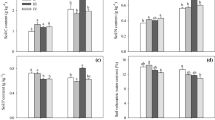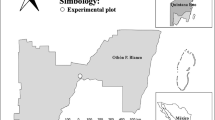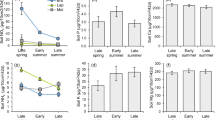Abstract
Belowground biomass production is a vital process that contributes to carbon sequestration. The relative proportion of belowground carbon allocation, however, varies with species, age, ecoclimatic conditions and crown dominance categories of trees. Here we compare the coarse root biomass and nutrient stocks of different stem size/crown class categories of 21-year-old Grevillea robusta stand in Kerala, India and the soil carbon/nutrient stocks of the G. robusta stand with an adjoining unplanted site. Root systems of 18 trees of three stem diameter/crown classes (5–15, 15–25, and >25 cm: suppressed + intermediate, co-dominant and dominant crown classes, respectively) were excavated and their coarse root biomass estimated. Mean coarse root biomass ranged from 12.94 to 59.81 kg tree−1 with production of 18.45 Mg ha−1 (mean annual increment = 0.88 Mg ha−1 year−1). Medium sized trees (co-dominant) had the highest root:shoot ratio, followed by intermediate and suppressed crown classes and the dominant trees had the least values, implying persistence strategies of the suppressed, intermediate and co-dominant trees under conditions of resource limitation. Coarse roots accounted for 8.04 Mg ha−1 C while soil organic carbon pool (0–100 cm) was 77.56 Mg ha−1 C, as against 66.04 Mg ha−1 for contiguous treeless plots. Coarse roots accrued 24.87 kg N, 1.66 kg P and 21.06 kg K per ha. G. robusta stand exhibited higher NPK stocks in the lower soil layers, compared to treeless controls. Deep rooted G. robusta trees (>1.0 m) thus have the potential to enrich lower layers of the soil profile through plant cycling of nutrients, which is important for on-site nutrient conservation and resource sharing with associated field crops.




Similar content being viewed by others
References
Anderson JM, Ingram JSI (1989) Tropical soil biology and fertility, a handbook of methods. CAB International, Wallingford, p 171
Aneesh S (2014) Biomass production and nutrient dynamics in a multipurpose tree based black pepper production system. Master’s Thesis, Kerala Agricultural University, 100 pp
Angers DA, Chenu C (1997) Dynamics of soil aggregation and C sequestration. In: Lal R, Kimble JM, Follett RF, Stewart BA (eds) Soil processes and the carbon cycle. CRC Press, Boca Raton, pp 199–206
Bambrick AD, Whalen JK, Bradley RL, Cogliastro A, Gordon AM, Olivier A, Thevathasan NV (2010) Spatial heterogeneity of soil organic carbon in tree-based intercropping systems in Quebec and Ontario, Canada. Agrofor Syst 79:343–353
Borden KA, Isaac ME, Thevathasan NV, Gordon AV, Thomas SC (2014) Estimating coarse root biomass with ground penetrating radar in a tree-based intercropping system. Agrofor Syst 88(4):657–669
Brunner I, Godbold DL (2007) Tree roots in a changing world. J For Res 12:78–82
Cairns MA, Brown S, Helmer EH, Baumgardner GA (1997) Root biomass allocation in the world’s upland forests. Oecologia 111:1–11
Campbell JS, Liefers J, Pielor EC (1985) Regression equations for estimating single tree biomass of trembling g aspen: assessing their applicability to more than one population. For Ecol Manag 11:283–295
Chesney P (2008) Nitrogen and fine root length dynamics in a tropical agroforestry system with periodically pruned Erythrina poeppigiana. Agrofor Syst 72(2):149–159
FAO (2006) State of the world’s forest 2005. FAO, Rome, p 166
Gerhardt K, Fredriksson D (1995) Biomass allocation by broadleaf mahogany seedlings, Swietenia macrophylla (King), in abandoned pasture and secondary dry forest in Guanacaste, Costa Rica. Biotropica 27:174–182
Giardina CP, Ryan MG (2002) Total belowground carbon allocation in a fast growing eucalyptus plantation estimated using a carbon balance approach. Ecosystems 5:487–499
Gill SJ, Biging GS, Murphy EC (2000) Modeling conifer tree crown radius and estimating canopy cover. For Ecol Manag 126(3):405–416
Harwood CE (1989) Grevillea robusta, an annotated bibliography. International Council for Research in Agroforestry, Nairobi, p 123
Jackson ML (1958) Soil chemical analysis. Asia Publishing House, New Delhi, p 498
Jamaludheen V, Kumar BM (1999) Litter of nine multipurpose trees in Kerala, India—variations in the amount, quality, decay rates and release of nutrients. For Ecol Manag 115:1–11
Jangra R, Gupta SR, Kumar R, Singh G (2010) Carbon sequestration in the Grevillea robusta plantation on a reclaimed sodic soil at Karnal in Northern India. Int J Ecol Environ Sci 36(1):75–86
Jones M, Sinclair FL, Grime VL (1998) Effect of tree species and crown pruning on root length and soil water content in semi-arid agroforestry. Plant Soil 201(2):197–207
Jose S (2009) Agroforestry for ecosystem services and environmental benefits: an overview. Agrofor Syst 76:1–10
Klepper B (1991) Root–shoot relationships. In: Waisel Y, Eshel A, Kafkafi U (eds) Plant roots: the hidden half. Marcel Dekker, New York, pp 265–286
Kongsager R, Napier J, Mertz O (2013) The carbon sequestration potential of tree crop plantations. Mitig Adapt Strateg Glob Change 18(8):1197–1213
Kraenzel M, Castillo A, Moore T, Potvina C (2003) Carbon storage of harvest-age teak (Tectona grandis) plantations, Panama. For Ecol Manag 173(1–3):213–225
Kumar BM (2008) Litter dynamics in plantation and agroforestry systems of the tropics—a review of observations and methods. In: Batish DR, Kohli RK, Jose S, Singh HP (eds) Ecological basis of agroforestry. CRC Press, Boca Raton, pp 181–216
Kumar BM, George SJ, Jamaludheen V, Suresh TK (1998) Comparison of biomass production, tree allometry and nutrient use efficiency of multipurpose trees grown in woodlot and silvopastoral experiments in Kerala, India. For Ecol Manag 112(1–2):145–163
Kuyah S, Dietz J, Muthuri C, Jamnadas R, Mwangi P, Coe R, Neufeldt H (2012) Allometric equations for estimating biomass in agricultural landscapes: II. Belowground biomass. Agric Ecosyst Environ 158:225–234
Lal R (2005) Forest soils and carbon sequestration. For Ecol Manag 220:242–258
Lal R, Kimble JM (2000) Tropical ecosystems and the global C cycle. In: Lal R, Kimble JM, Stewart BA (eds) Global climate change and tropical ecosystems. CRC Press, Boca Raton, pp 3–32
Liao C, Luo Y, Fang C, Li B (2010) Ecosystem carbon stock influenced by plantation practice: implications for planting forests as a measure of climate change mitigation. PLoS ONE 5(5):e10867. doi:10.1371/journal.pone.0010867
Long JN, Smith FW (1984) Relation between size and density in developing stands: a description and possible mechanisms. For Ecol Manag 7:191–206
Markesteijn L, Poorter L (2009) Seedling root morphology and biomass allocation of 62 tropical tree species in relation to drought- and shade-tolerance. J Ecol 97:311–325
Mokany K, Raison JR, Prokushkin A (2006) Critical analysis of root:shoot ratios in terrestrial biomes. Glob Change Biol 12:84–96
Montagnini F, Nair PKR (2004) Carbon sequestration: an underexploited environmental benefit of agroforestry systems. Agrofor Syst 61:281–295
Nadelhoffer KJ, Raich JW (1992) Fine root production estimates and belowground carbon allocation in forest ecosystems. Ecology 73:1139–1147
Naidu SL, DeLucia EH, Thomas RB (1998) Contrasting patterns of biomass allocation in dominant and suppressed loblolly pine. Can J For Res 28(8):1116–1124
Nair PKR, Kumar BM, Nair VD (2009) Agroforestry as a strategy for carbon sequestration. J Plant Nutr Soil Sci 172(1):10–23
Nair PKR, Nair VD, Kumar BM, Showalter JM (2010) Carbon sequestration in agroforestry systems. Adv Agron 108:237–307
Nilsson U, Albrektson A (1994) Productivity of needles and allocation of growth in young Scots pine trees of different competitive status. For Ecol Manag 62:173–187
Oelbermann MTR, Voroney P, Kass DCL, Schlfnvoigt AM (2006) Soil carbon and nitrogen dynamics using stable isotopes in 19- and 10-year-old tropical agroforestry systems. Geoderma 130:356–367
Paquette A, Messier C (2010) The role of plantations in managing the world’s forests in the Anthropocene. Front Ecol Environ 8:27–34
Paul GB (2012) Biomass and carbon sequestration in silver oak (Grevillea robusta A. Cunn.) stands in the midlands of Kerala. MSc Thesis, Kerala Agricultural University, Thrissur, p 83
Peichl M, Arain MA (2006) Above- and belowground ecosystem biomass and carbon pools in an age-sequence of temperate pine plantation forests. Agric For Met 140(1–4):51–63
Raich JW, Clark DA, Schwendenmann L, Wood TE (2014) Aboveground tree growth varies with belowground carbon allocation in a tropical rainforest environment. PLoS ONE 9(6):e100275. doi:10.1371/journal.pone.0100275
Sanchez PA (1995) Science in agroforestry. Agrofor Syst 30:5–55
Sanford RL Jr, Cuevas E (1996) Root growth and rhizosphere interactions in tropical forests. In: Mulkey SS, Chazdon RL, Smith AP (eds) Tropical forest plant ecophysiology. Chapman and Hall, New York, pp 268–300
Shanavas A, Kumar BM (2006) Physical and mechanical properties of three agroforestry tree species from Kerala, India. J Trop Agric 44:23–30
Spurr SH, Barnes BV (1980) Forest ecology. Wiley, New York
Tomlinson KW, Sterck FJ, Bongers F, da Silva DA, Barbosa ERM, Ward D, Bakker FT, van Kaauwen M, Prins HHT, de Bie S, van Langevelde F (2012) Biomass partitioning and root morphology of savanna trees across a water gradient. J Ecol 100:1113–1121
Uri V, Varik M, Aosaar J, Kanal A, Kukumagi M, Lohmus K (2012) Biomass production and carbon sequestration in a fertile silver birch (Betula pendula Roth) forest chronosequence. For Ecol Manag 267:117–126
Van Lear DH, Kapeluck PR (1995) Above- and below- stump biomass and nutrient content of a mature loblolly pine planation. Can J For Res 25:361–367
Walkley A, Black IA (1934) An examination of the Degtjareff method for determining organic carbon in soils: effect of variations in digestion conditions and of inorganic soil constituents. Soil Sci 63:251–263
Young A (1997) Agroforestry for soil management, 2nd edn. ICRAF and CAB International, Wallingford, p 320
Acknowledgments
This work forms part of the master’s dissertation project of the first author. The original experiment was established using a research grant from the World Bank funded social forestry programme of Kerala Government to B. Mohan Kumar during 1991. The authors also acknowledge partial funding of the present research from the All India coordinated research project on Agroforestry of the Indian Council of Agricultural Research, New Delhi and the laboratory and other facilities provided by Kerala Agricultural University, Vellanikkara.
Author information
Authors and Affiliations
Corresponding author
Rights and permissions
About this article
Cite this article
Thakur, S., Kumar, B.M. & Kunhamu, T.K. Coarse root biomass, carbon, and nutrient stock dynamics of different stem and crown classes of silver oak (Grevillea robusta A. Cunn. ex. R. Br.) plantation in Central Kerala, India. Agroforest Syst 89, 869–883 (2015). https://doi.org/10.1007/s10457-015-9821-y
Received:
Accepted:
Published:
Issue Date:
DOI: https://doi.org/10.1007/s10457-015-9821-y




